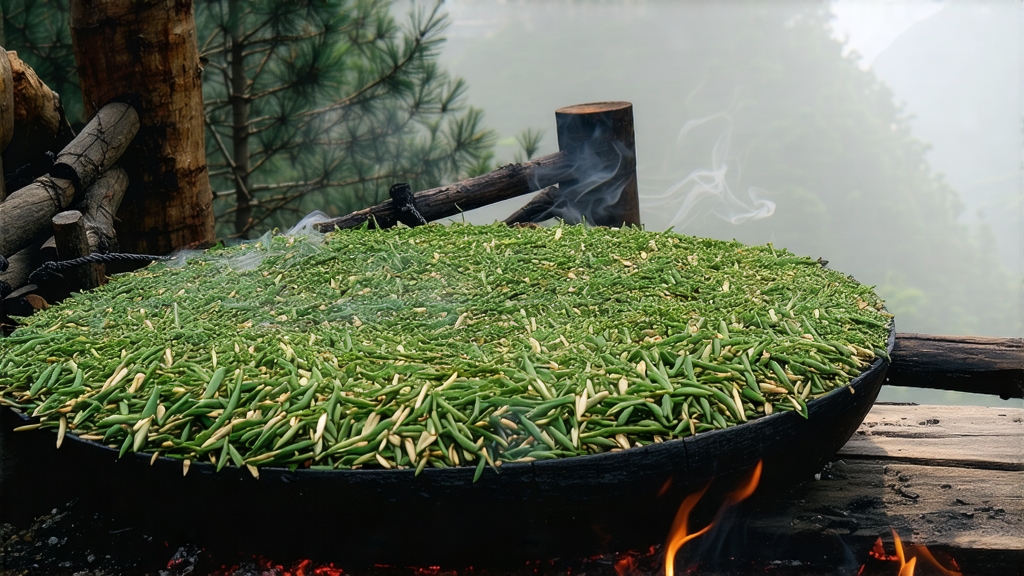
When European tea clippers first rounded the Cape of Good Hope in the early seventeenth century, the cargo that most excited London merchants was not silk or porcelain but small, glossy leaves that smelled of campfire and treacle. Those leaves came from Tongmu, a protected gorge tucked inside China’s Wuyi Mountains, and they would soon be christened “Lapsang Souchong,” a name that still evokes mystery and polarized devotion among tea drinkers today. To understand why this tea—literally the first black tea ever created—carries such aromatic swagger, one must follow the Min River upstream, past bamboo groves and granite cliffs, into a microclimate so humid that tea makers turned smoke into a preservative and, in doing so, invented a genre.
Historical records kept by the Jianyang county annals place the birth of Lapsang Souchong around 1568, late in the Ming dynasty, when a passing army requisitioned the drying sheds of local tea farmers. To hasten the process and keep the leaves from spoiling in the monsoon air, the farmers spread them over pine fires. The resulting tea, copper-black and laced with resinous sweetness, found favor with Dutch traders at the port of Xiamen, who paid in silver and spread it across the Baltic and North Sea ports. By the 1660s the British East India Company listed “Bohea Souchong” (a corruption of “Wuyi” and the Amoy dialect term xiao-zhong, “small cultivar”) among its most valuable commodities, priced above even the finest green teas. Thus, long before Assam or Ceylon estates existed, Lapsang Souchong defined what “black tea” meant to the Western palate.
The terroir that shaped this tea is as dramatic as its origin tale. Tongmu sits at 27° north latitude, averaging 200 foggy days a year; the gorge traps cool air from the Huanggang summit, creating a diurnal swing of 15 °C that slows leaf growth and concentrates amino acids. The soil is a coarse, mineral-rich laterite weathered from volcanic tuff, so porous that rainwater disappears within minutes, forcing tea roots to dive deep for nutrients. Indigenous populations of small-leaf Camellia sinensis var. sinensis have evolved extra wax layers on their epidermis to resist the constant moisture, a botanical detail that later allows the leaves to absorb smoke without turning acrid.
Within Tongmu, three grades of Lapsang are recognized by the local Tea Inspection Station. The highest, simply called “Original Grove,” is picked from century-old seed-propagated bushes scattered at 1,200 m among wild azalea and plum trees. Only the top two leaves and a bud are plucked before the Qingming festival, when spring nights are still cold enough to lock in floral aromatics. The second grade, “High Mountain,” comes from terraced gardens above 800 m planted in the 1950s using cuttings from the original grove; here leaf size is slightly larger, and the smoke is softer. The third, “Wuyi Congou,” blends lower-elevation leaves with some pan-fired material, yielding a sweeter, less assertive cup designed for modern markets that shy away from heavy tar notes.
Crafting Lapsang Souchong is a choreography of withering, smoking, rolling, oxidizing, and re-smoking that unfolds over 26 hours with almost no pause. Fresh leaves are first spread 3 cm deep on bamboo trays set in the upper story of a three-level wooden house; below, embers of local Masson pine glow at 80 °C, never flaming, releasing a steady plume rich in α-pinene and longifolene. Every 20 minutes the trays are rotated so that each leaf receives the same gentle desiccation; moisture drops from 74 % to 58 % in four hours, and the cellular membranes begin to leak polyphenols that will later oxidize into theaflavins. Next comes rolling: 5 kg batches are tumbled in a cast-iron drum rotating at 28 rpm for 45 minutes, just enough to bruise the edges and expose catechins to atmospheric oxygen. The leaves are then piled 30 cm high in wicker baskets, covered with damp cotton, and left in a pine-warmed room for three hours. In this cozy hothouse, oxidation races forward, turning the leaf color from jade to copper; master sniffers